The finite element method for diffusion problems with two phases: XFEM and XFEM+ q
Published 2019-01-01
Keywords
- Finite element method,
- extended finite element method,
- XFEM,
- extended finite element method modified,
- two phase problems
How to Cite
Abstract
Obtaining precise solutions with the finite element method (FEM) for diffusive problems with multiple phases entails a high computational cost. For this reason, the extended finite element method (XFEM) has become the usual tool for the analysis of this type of problems. However, when XFEM is applied to two-phase problems with very different conductivities, inaccurate representations of the flows in the vicinity of the interface are obtained. To alleviate this deficiency of the XFEM, additional restrictions must be added to the method, originating a modification of it, known as XFEM+. Since XFEM+ is relatively recent and little known and implemented at the time of designing applications for real problems of engineering and science, this paper presents its theoretical development, as well as the numerical results obtained for 2D problems, compared to FEM and XFEM. A contribution of this work is given by the implementation of the methods for quadrilateral elements. The numerical results obtained for this type of elements, and different interfaces, show the remarkable improvement of the XFEM when increasing the order of interpolation.
Downloads
References
R. Clough and Y. Rashid, “Finite element analysis of axisymmetric solids,” Journal of the Engineering Mechanics Division, 1965, Vol. 91, Issue 1, Pg. 71-86, vol. 91, no. 1, pp. 71–86, 1965.
H. Martin, Introduction to Matrix Methods of Structural Analysis. Mc Graw Hill Book Company, New York, 1966.
S. Pawsey and R. Clough, “Improved numerical integration of thick shell finite elements,” International Journal for Numerical Methods in Engineering, vol. 3, no. 4, pp. 575–586, 1971.
M. Turner, R. Clough, H. Martin, and L. Topp, “Stiffness and deflection analysis of complex structures,” Journal of Aerospace Science and Technologies, vol. 23, pp. 805–824, 1956.
O. Zienkiewicz and R. Taylor, El Metodo de los Elementos Finitos: Formulación básica y problemas lineales,4th ed. McGraw Hill Book Company, 1994, vol. 1.
T. Belystchko and T. Black, “Elastic crack growth in finite elements with minimal remeshing,” International Journal for Numerical Methods in Engineering, no. 45 (5), pp. 601–620, 1999.
J.Chessa and T. Belystchko,“An extended finite element method for two-phase fluids,”Transactions of the ASME,vol. 70, pp. 10– 17, 2003. El método de los elementos finitos para problemas de difusión con dos fases: XFEM y XFEM+ 221
C. Daux, N. Moes, J. Dolbow, N. Sukumar, and T. Belystchko, “Arbitrary branched and intersecting cracks with the extended finite element method,” International Journal for Numerical Methods in Engineering, no. 48, pp. 1741–1760, 2000.
T. P. Fries and T. Belytschko, “The extended/generalized finite element method: An overview of the method and its applications,” International Journal for Numerical Methods in Engineering, vol. 84, no. 3, pp. 253–304, 2010.
N. Moës, J. Dolbow,and T. Belystchko,“A finite element method for crack growth without remeshing,” International Journal for Numerical Methods in Engineering, no. 46, pp. 131–150, 1999.
Q. Xiao and B. Karihaloo,“Improving the accuracy of xfem crack tip fields using higher order quadrature and statically admissible stress recovery,” International Journal for Numerical Methods in Engineering, no. 66 (9), pp. 1378–1410, 2006.
S. Zlotnik, P. Díez, M. Fernández and J. Vergés,“Numerical modelling of tectonic plates subduction using X-FEM,” Computer Methods in Applied Mechanics and Engineering, no. 196, pp. 4283–4293, 2007.
J. Ródenas, O. González-Estrada,F. Fuenmayor and F. Chinesta, “Enhanced error estimator based on a nearly equilibrated moving leasts quares recovery technique for fem and xfem,”Computational Mechanics, no. 52 (2), pp. 321–344, 2013.
O. González-Estrada, S. Natarajan, and C. Graciano, “Reconstrucción de tensiones para el método de elementos finitos con mallas poligonales,” Revista UIS Ingenierías, no. 16 (1), pp. 23– 34, 2017.
F. Cordero and P. Díez, “XFEM+: una modificación de XFEM para mejorar la precisión de los flujos locales en problemas de difusión con conductividad es muy distintas,” Revista Internacional Métodos Numéricos para Cálculo y Diseño en Ingeniería, vol. 2, no. 26, pp. 121–133, 2010.

